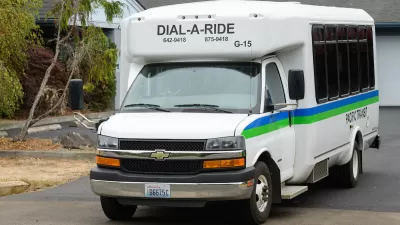Minnesota’s on-demand microtransit service is helping connect residents to fixed-route service and daily needs.

Some transit services that are including on-demand services are seeing bigger increases in ridership, according to an article in the Minnesota Reformer, as post-pandemic travel patterns shift away from the typical 9-to-5 commutes.
In Minnesota, the Minnesota Valley Transit’s Connect service “is so popular that it’s having trouble keeping up with demand, even as the Legislature allocated over $9 million last year to build out Connect and similar systems statewide.”
Unlike other dial-a-ride services, Connect and other microtransit options offer service within an hour or less. It also lets passengers board without a reservation when the bus stops to pick up someone else.
Microtransit options can work well in less-dense areas and suburbs where few other transit options are available and where ridership is sparse. However, the per-mile cost of these services can be prohibitive to some agencies and, some have argued, does not scale well. For example, “To manage demand, MVTA only allows riders to book rides up to three hours ahead of time, while also cutting some regular bus service in September to ensure they have enough drivers to provide the service in their existing areas.”
FULL STORY: Local transit agencies mimicking Uber and Lyft are seeing big ridership gains

Alabama: Trump Terminates Settlements for Black Communities Harmed By Raw Sewage
Trump deemed the landmark civil rights agreement “illegal DEI and environmental justice policy.”

Planetizen Federal Action Tracker
A weekly monitor of how Trump’s orders and actions are impacting planners and planning in America.

The 120 Year Old Tiny Home Villages That Sheltered San Francisco’s Earthquake Refugees
More than a century ago, San Francisco mobilized to house thousands of residents displaced by the 1906 earthquake. Could their strategy offer a model for the present?

Seattle Voters Approve Social Housing Referendum
Voters approved a corporate tax to fund the city’s housing authority despite an opposition campaign funded by Amazon and Microsoft.

The Five Most-Changed American Cities
A ranking of population change, home values, and jobs highlights the nation’s most dynamic and most stagnant regions.

USDOT Repeals Emissions Monitoring Rule
A Biden-era regulation required states to report and plan to reduce transportation-related emissions.
Urban Design for Planners 1: Software Tools
This six-course series explores essential urban design concepts using open source software and equips planners with the tools they need to participate fully in the urban design process.
Planning for Universal Design
Learn the tools for implementing Universal Design in planning regulations.
Clanton & Associates, Inc.
Jessamine County Fiscal Court
Institute for Housing and Urban Development Studies (IHS)
City of Grandview
Harvard GSD Executive Education
Toledo-Lucas County Plan Commissions
Salt Lake City
NYU Wagner Graduate School of Public Service





























